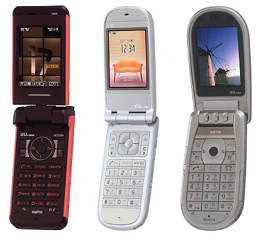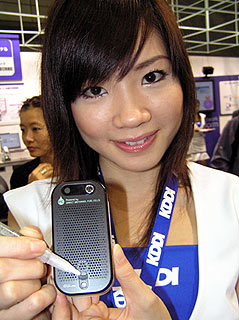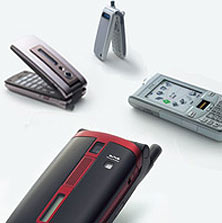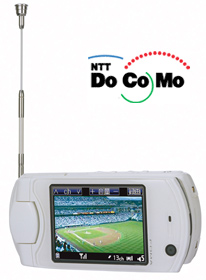KDDI's New Trio of 3G handsets
 Japan’s KDDI is promoting three new handsets coming out later this month that they believe mix fun with functionality for a package of business and entertainment features.
Japan’s KDDI is promoting three new handsets coming out later this month that they believe mix fun with functionality for a package of business and entertainment features.
The W33SA from Sanyo, W32T by Toshiba and Kyocera’s A5515K each pack a push-to-talk style function. The trio of handsets comes equipped with Hello Messenger, a live audio-chat style service for up to five people that supports voice, image and text simultaneously. Twelve original cartoon-style avatars by well-known Japanese illustrator Kohei Yamashita will frolic on screen as stand-ins for chat members who can type or talk through the conversation over the handsets.
Targeted at young, female users, chat members register each other’s number in their handset to get started. Prices for the service of course vary depending on if subscribers have a flat rate package or not. If not then there is a charge incurred for sending photos or data. A special introductory rate for the audio portion of Hello Messenger until April, for example, will be 1.05 yen per 20 seconds. Scheduled to start service in late November.



 Japan’s
Japan’s  DoCoMo has developed their first mobile handset to receive terrestrial digital broadcasting and analog TV in one 3G Foma package. The P901iTV handset, by Panasonic, targets the start of mobile digital broadcasting in April, 2006 and will make its public debut at the upcoming CEATEC Japan 2005 trade show October 4 to 8 at Makuhari Messe convention center in Chiba. (WWJ will be on-hand to get photos and video!)
DoCoMo has developed their first mobile handset to receive terrestrial digital broadcasting and analog TV in one 3G Foma package. The P901iTV handset, by Panasonic, targets the start of mobile digital broadcasting in April, 2006 and will make its public debut at the upcoming CEATEC Japan 2005 trade show October 4 to 8 at Makuhari Messe convention center in Chiba. (WWJ will be on-hand to get photos and video!)